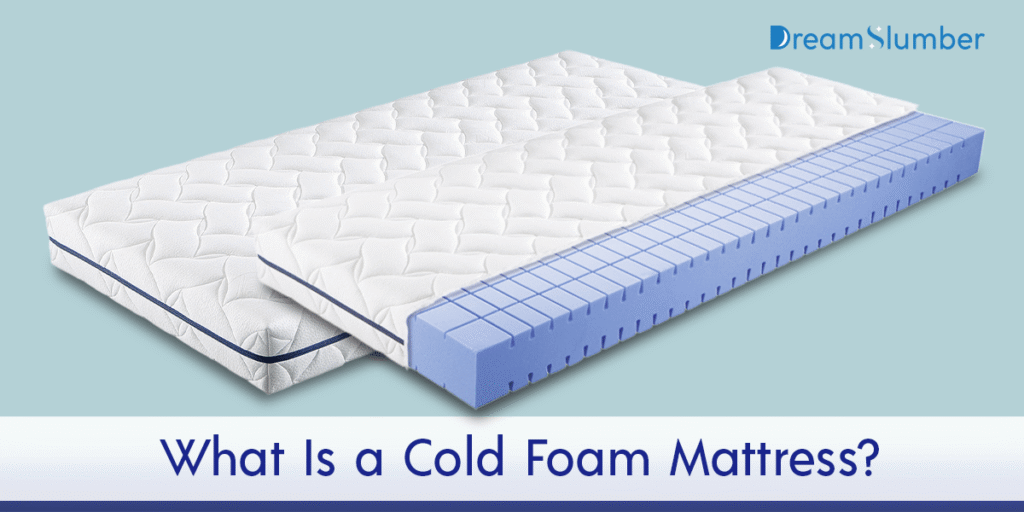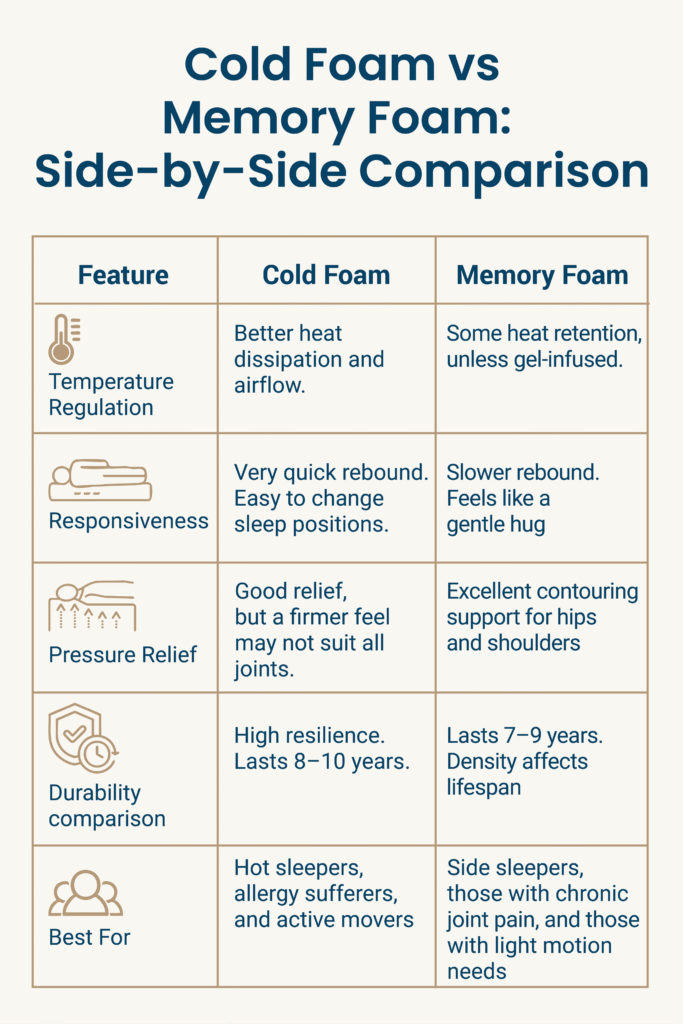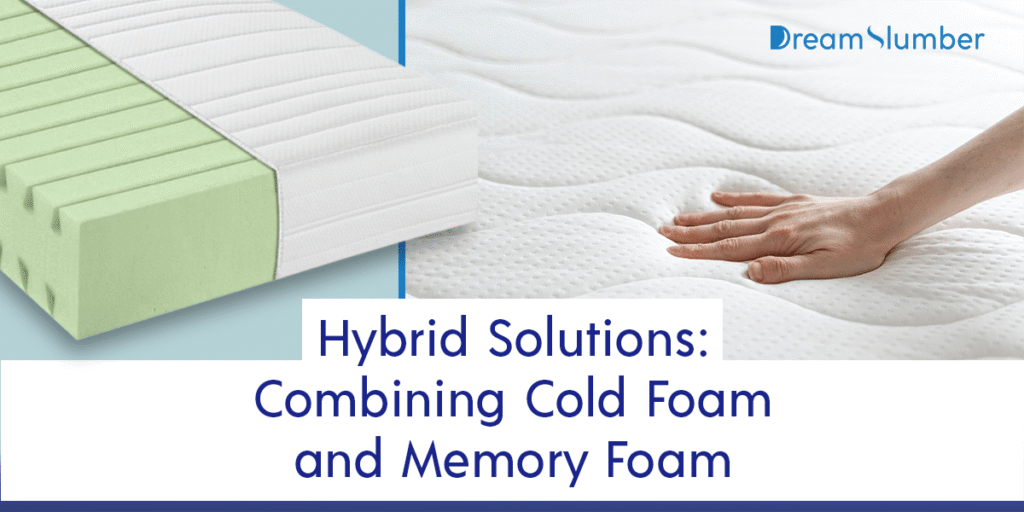When you purchase through our links, we may earn a commission at no extra cost to you. As an Amazon Associate, DreamSlumber earns from qualifying purchases. Learn more.
⭐ Quick Verdict: Cold Foam Mattress vs Memory Foam
Cold foam (HR polyurethane) is best if you want cooler sleep, responsive bounce, and lightweight durability at a friendly price.
Memory foam is better if you prefer deep pressure relief, body-hugging contouring, and top-tier motion isolation for pain relief and couples.
- Best for Hot & Combo Sleepers → Cold Foam
- Best for Pressure Relief & Side Sleepers → Memory Foam
- Best for Motion Isolation & Light Sleepers → Memory Foam
Keep reading for material differences, firmness options, and real-world performance tips.
Do you wake up feeling tired, achy, or stiff in the morning? Many people struggle with poor sleep quality these days. Some wake up sweating. Others feel pain in their back or joints. It often starts with one thing: the wrong mattress.
More adults now prioritize pressure relief, temperature regulation, and spinal alignment when purchasing a mattress. Comfort alone is not enough anymore. People want a mattress that supports their overall wellness, both physically and mentally.
Cold foam and memory foam are two of the most popular foam mattresses today. Each has its own benefits for better sleep and better health.
But which one is right for you?
In this article, we’ll help you choose. We’ll compare “cold foam Mattress vs memory foam”. We’ll show you their benefits, pros, and cons, and how they support your sleep style.
Let’s start your journey to healthier, deeper, and more restful sleep.

What Is a Cold Foam Mattress?
Cold foam is also called HR foam. HR stands for high resilience. It’s a type of polyurethane foam, but it’s made with special air pockets. These help the foam stay firm and bouncy. It also keeps air flowing all night.
The word “cold” in cold foam doesn’t mean it’s cold to touch. It means the foam is made using a cold-cure process. This process utilizes lower heat, keeping the foam more breathable and resilient.
Cold foam is known for its advanced cooling foam technology that prevents heat buildup. It doesn’t trap body heat like some other foams. That’s why many hot sleepers prefer cold foam over traditional memory foam.
Today, cold foam mattresses have continued to improve. Some now use open-cell structures that allow more airflow. For a cooling option, consider the Vibe 12-inch Gel Memory Foam Mattress, or Zinus 12″ Green Tea Memory Foam, which features CertiPUR-US certified open-cell foam with a gel-infused layer for temperature regulation and heat reduction, making it an ideal choice for hot sleepers.
A recent report indicates that over 72% of consumers now purchase more green products than they did five years ago.
Cold foam mattresses are also hypoallergenic. They resist dust mites and mold, making them ideal for people with allergies.
They provide firm support, keeping your spine aligned. This helps improve sleep posture and reduces pressure on your back.
Because they bounce back quickly, they are easier to move on from. This makes cold foam ideal for couples or individuals who frequently change positions.

What Is a Memory Foam Mattress?
Memory foam is soft and slow-moving. It was first made by NASA in the 1960s. They used it to protect astronauts during space missions. Later, it became popular in pillows and mattresses.
Memory foam is highly popular due to its viscoelastic properties. This means it changes shape when you press it, then slowly returns to its standard shape. It hugs your body and helps reduce pressure points.
This deep “hug” gives joint pain relief and helps you feel weightless. That’s why many people with back or shoulder pain find it beneficial. For example, the Nectar Classic Hybrid Mattress combines gel memory foam with coils to provide deep pressure relief and cooling, making it ideal for side sleepers with joint pain.
In the coming days, memory foam will be much more advanced. New types include:
- Plant-based memory foam, made from natural oils.
- Graphene-infused layers, which pull heat away from your body.
- Gel-infused memory foam, which improves temperature regulation
These updates will make memory foam more eco-friendly and better for hot sleepers.
Memory foam also absorbs movement. This is called motion isolation. If your partner moves during sleep, you won’t feel much. That makes it a good choice for couples.
But memory foam does have some drawbacks. It can trap heat if it’s not made from gel or plant-based materials. It also takes longer to bounce back when you move.
Some people dislike the “sinking in” sensation. Others say it’s harder to get out of bed.
Still, memory foam is a favorite for people who want:
- Contouring support
- Pressure relief mattress
- Quiet, still sleep
- Help with pain or stress
Memory foam is also used in many hybrid mattresses and adjustable beds. Its soft, deep support helps relax both the body and mind.

Cold Foam vs Memory Foam: Side-by-Side Comparison
| Feature | Cold Foam | Memory Foam |
| Temperature Regulation | Better heat dissipation and airflow. | Some heat retention, unless gel-infused. |
| Responsiveness | Very quick rebound. Easy to change sleep positions. | Slower rebound. Feels like a gentle hug |
| Pressure Relief | Good relief, but a firmer feel may not suit all joints. | Excellent contouring support for hips and shoulders |
| Durability comparison | High resilience. Lasts 8–10 years. | Lasts 7–9 years. Density affects lifespan |
| Best For | Hot sleepers, allergy sufferers, and active movers | Side sleepers, those with chronic joint pain, and those with light motion needs |
Pros and Cons: Which Foam Suits Your Sleep Style?
Cold Foam Pros
- Hypoallergenic sleep surface. Great for allergy-friendly materials.
- Durable. A substantial, long-term mattress investment.
- Excellent temperature regulation and cooling mattress technology.
- Responsive sleep surface. Easy to shift positions.
Cold Foam Cons
- Less contouring support around curves.
- Firm mattresses may not be suitable for side sleepers.
- Some find it too bouncy for deep sink-in comfort.
Memory Foam Pros
- Superior pressure relief mattress, especially in arthritis-friendly mattresses.
- Outstanding motion isolation. Partners won’t disturb you.
- Contouring support hugs your body.
- Helps improve sleep posture and stress relief.
Memory Foam Cons
- Potential off-gassing concerns upon first unpacking.
- Can trap heat if not gel- or plant-infused.
- Slower responsiveness can feel stuck.
Health and Wellness Benefits: Which Foam Supports Your Body?
Clinical studies in 2025 have linked each foam to key health benefits.
| Health Need | Cold Foam | Memory Foam |
| Back Pain | Improves spinal alignment with firm, level support. | Eases pressure on the lumbar area. Reduces back pain. |
| Arthritis / Joint Pain | Provides solid support, but fewer hugs. Good for mild joint issues. | Soft contouring helps ease arthritis pain and reduce inflammation, similar to specialized chronic pain relief mattresses. |
| Allergies | Allergy-friendly materials resist dust mites and mold. | Some foams can trap allergens unless treated. |

Hybrid Solutions: Combining Cold Foam and Memory Foam
Let’s say you like the comfort of memory foam. But you also want airflow and bounce. That’s where hybrid mattresses come in.
Trending Hybrid Designs in 2025
Hybrid mattresses are a top trend in 2025. They combine cold foam, memory foam, and sometimes pocketed coils.
This mix helps balance support, pressure relief, and cooling. Many newer designs focus on improving sleep for hot sleepers, individuals with joint pain, or couples who frequently toss and turn.
Some popular designs include:
- Gel-infused memory foam top layer for a calm sleep
- Cold foam base layer for airflow and firmness
- Zoned support for better spinal alignment
- Graphene or copper layers to fight heat and bacteria
Industry reports consistently show that hybrid mattresses are a rapidly growing segment of the mattress market. For example, Grand View Research projects that the hybrid mattress market will have a CAGR of 6.8% from 2025 to 2030. Meanwhile, Mordor Intelligence forecasts a compound annual growth rate (CAGR) of 13.87% from 2025 to 2030.
Brands Leading the Way
Several brands now use eco-friendly foam and allergy-friendly materials in their hybrid beds. Here are some examples:
- Emma Hybrid Premium (2025 Model): Uses HR cold foam, Airgocell®, and memory foam. Known for spine support and cooling.
- Tempur Adapt Hybrid: Combines NASA-based memory foam with responsive foam and spring support.
- Avocado Green Hybrid: Utilizes plant-based latex, certified foams, and natural materials. Great for allergy sufferers.
- MLILY Fusion Luxe: Includes bamboo charcoal memory foam and cold foam layers for freshness and comfort.
These mattresses focus on comfort, pressure relief, motion isolation, and breathability.
Balanced Comfort for Holistic Sleep
Hybrid mattresses are designed to give you the best of both worlds.
Memory foam gives a soft, contouring feel. It helps ease joint pain and reduce stress. Cold foam adds firmness, bounce, and airflow. It keeps your body lifted and cool.
Together, they support your spinal alignment, improve sleep posture, and help you stay asleep longer. Top hybrid mattresses include:
- Zinus 12″ Hybrid: This gel-infused hybrid mattress helps keep you comfortable at night.
- Linenspa Memory Foam and Spring Hybrid: Quality Comfort and Adaptive Support.
A good hybrid bed can improve:
- Joint pain relief
- Night sweats and hot flashes
- Allergy symptoms
- Back and neck tension
According to a 2025 clinical review by the European Sleep Research Society, people using hybrid mattresses had better sleep quality and lower morning pain.

Frequently Asked Questions
Does cold foam sleep cooler than memory foam?
Yes, cold foam usually sleeps cooler than memory foam. It has an open-cell structure that allows air to move freely. This helps reduce heat buildup during the night. It’s a good option for hot sleepers.
Which mattress is better for back pain: cold foam or memory foam?
Memory foam is better suited for those who require deep pressure relief. It gently hugs your body and supports your spine. Cold foam provides firmer support and may be beneficial if you prefer a stable surface. Both can help, but the best choice depends on your comfort needs.
Can memory foam mattresses cause overheating?
Yes, some memory foam mattresses can trap heat. Older types don’t allow much airflow. However, newer models utilize gel or copper layers to maintain their coolness. Always look for cooling features if you’re a hot sleeper.
Are cold foam mattresses good for couples?
Yes, they are great for couples. Cold foam absorbs movement well, so you won’t feel your partner move. It also keeps its shape, even if you sleep in different spots. Plus, it’s more breathable than dense foam.
How long does a memory foam mattress last?
Most memory foam mattresses last about 7 to 10 years. High-density foams tend to last longer. Proper care helps extend its lifespan.
Is cold foam eco-friendly?
Cold foam can be eco-friendly if made with safe, certified materials. Many brands now use CertiPUR-US® or OEKO-TEX® certified foams. Some even add plant-based ingredients. Always check the labels and certifications.
Which foam is best for stomach sleepers?
Cold foam is better for stomach sleepers. It offers a firmer, more supportive surface. Too-soft foam can cause lower back strain.
Do memory foam mattresses sag over time?
Yes, they can sag with age, especially if the foam is of low quality. Heavy use and poor support also speed up sagging. High-density memory foam lasts longer and sags less. Using a solid base can help maintain shape.
Conclusion
Mattresses play a significant role in your sleep, which is essential for your overall wellness. In the Cold Foam Mattress vs Memory Foam choice, each has its own benefits. Cold foam is cooler, firmer, and great for airflow. Memory foam offers deep comfort and pressure relief. Consider your body’s needs, sleep habits, and overall comfort. Hybrid mattresses also provide a nice balance of both foams. Based on your needs:
- Budget-friendly → Zinus 12″ Hybrid
- Hot sleepers → Vibe Gel Memory Foam
- Chronic pain → Nectar Classic Hybrid
Whatever you choose, try it during a sleep trial if possible. Good sleep starts with the proper support.


